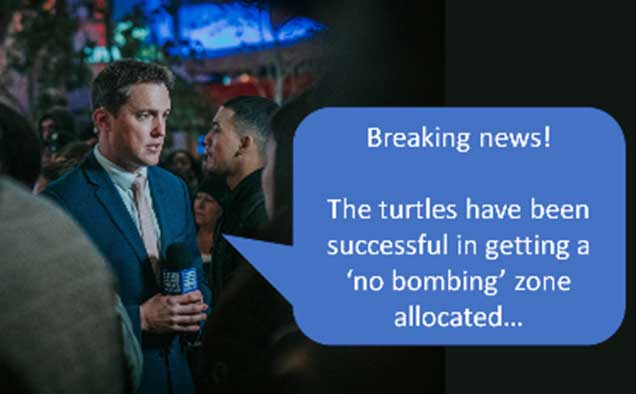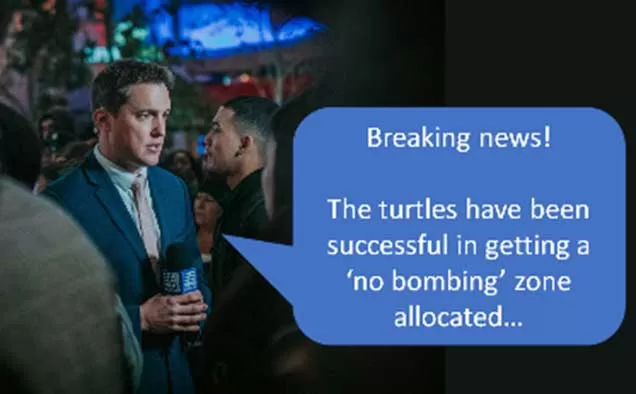“The Red Sea’s underwater eco-system is home to over 300 species of coral and 2,100 species of fish, 10% of which are found nowhere else in the world. Spinner dolphins, dugongs, turtles, mantas, and sharks are just some of the marine species that calls these waters home…” [Living Oceans Foundation]
What effect would major warfare; with its missiles; drone attacks; electronic warfare; sea-mines; helicopter ship gunfire; and other assorted weaponry have upon the marine life in the Red Sea? What would happen if a ship oil tanker is bombed and an oil spill invades the Red Sea’s famous coral reefs and fish nurseries? For many species whose existence hangs by a thread, the short answer is that the thread would be severed. As the 21st Century progresses, increasingly, major warfare most likely means ecocide.
Oceanus nullius?
Nature is silent in warfare. It can’t speak. Strangely, this well-known characteristic of nature is rarely accounted for by humans. In diplomatic discourse; intelligence assessments; strategic policy planning or military operational planning, the creatures of the oceans, the skies, the forests, the wetlands, or the plains get scant regard.
Most war journalists don’t report on nature’s casualties either. There are few questions: “Jim, you’re on the frontline, can you tell us, how is nature getting on?”


Nature cannot speak in war. Image credit: Freddy Kearney, Unsplash.
The lack of optics – investigations; reporting; multi-media imagery (such as the iconic Vietnam War photos) – means that the broader global population, watching wars on their devices, are denied capacity to see the truth: the full-spectrum truth of war’s violence.
It also means that security strategists are proceeding with blinkers on. Akin to 15th to 17th century sea explorers, today’s western leaders remain gripped by a Terra Nullius or Oceanus Nullius mentality. It is a world view where nature’s creature’s lives mean nothing, where it as though they don’t even exist.
Lessons from history have not been heeded. We now know that Colonialism devasted local flora and fauna populations. As merely one example, bird species were decimated because people wanted beautiful feathers on their hats. We tut-tut such past errors, shake our heads at the ignorance and brutality, “how could they be so stupid?” yet repeat the same behaviour.
2024 ecological context
Lessons from modern ecological research have not been absorbed either. There have been decades of books, reports, global protests, and high-profile conferences on the worsening and extraordinary fragile state of earth’s ecology, climate and especially its oceans and marine life. Nature faces multi-pronged attacks, such as from habitat loss; harm from toxic waste dumping, litter and microplastics; global warming and the associated de-oxygenation of oceans; the illegal wildlife trade; over-fishing and more. Let me highlight merely a few factors that should be considered in any strategic planning in relation to the Red Sea.
Biodiversity in crisis
The 2019 Global Assessment Report on Biodiversity and Ecosystem Services Report told us that Earth’s biodiversity was ‘declining faster than at any time in human history’ and required ‘transformational’ change to halt or slow its deterioration.
Ocean heat
2024 begins with the scientific journal Nature reporting on the extraordinary heating of the world’s oceans. 2023 saw oceans absorb the largest amount of heat on record. Ocean heat records have been broken five years in a row. Pertinent to geopolitical tensions, the article notes how separate Chinese and US research reaches the same conclusions. Continued ocean heat increases will decimate marine life.
Red Sea Coral – of Global significance
The coral in the Red Sea has been found to be scientifically significant because of its capacity to endure warmer waters. It’s worth sharing the researchers’ key findings:
This uniquely resilient reef employs biological mechanisms which are likely to be important for coral survival as the planet’s oceans warm. The Gulf of Aqaba could potentially be one of the planet’s largest marine refuges from climate change. However, this unique portion of the Red Sea’s reef will only survive and flourish if serious regional environmental challenges are addressed. Localized anthropogenic stressors compound the effects of warming seawater to damage corals and should be mitigated immediately…. The countries bordering the entire Red Sea will need to cooperate to enable effective scientific research and conservation.
Who lives in the Red Sea?
For nature to have a voice in policy and security strategy, it is important to get away from statistics which remove nature’s significance as a magnificent expression of life and beauty. WE must remember that nature is not an inert ‘resource.’ Nature refers to non-human creatures who feel pain and fear, who have family and community connections and their own ways of communicating—which modern humans are only beginning to understand.
One way to help nature be seen in war is to simply to learn the names of species who live in the ‘battlefield’ and find out a bit about them, (see Table 1). It is sickening to think of the 4,000 remaining Dugong, currently on the ‘red list for threatened species,’ swimming in what could become a major war zone.
Table 1: Who lives in the Red Sea? A sample
| WHO LIVES IN THE RED SEA? | |
| ▶ 10 x Shark Species Oceanic White Tip Shark Hammerhead Shark Tiger Shark Grey Reef Shark Thresher Shark | Silky Shark Nurse Shark Black Tip Reef Shark White Tip Reef Shark Whale Shark |
| ▶ 4,000 x Dugong Dugongs spend most of their life in the shallow coastal areas grazing on sea grass beds. These sea grass beds are of enormous ecological importance and sustain an overwhelming amount of marine life. ⚠ Dugongs are on the IUCN Red List of Threatened Species. ⚠ Dugongs have been steadily retreating from their Red Sea coast because of tourist development. Eutrophication from industrial run-off and habitat destruction constitute the greatest threats to the Dugongs of the Red Sea. | |
| ▶ 5 x Turtle species Critically endangered: Hawksbill turtle (Eretmochelys imbricata) Leatherback turtle (Dermochelys coriacea), called the gentle giant by some, rarely seen nowadays. Endangered: Loggerhead turtle (Caretta caretta), known for its big head, can usually be spotted in the Gulf of Aden but rarely reaches the Egyptian Red Sea. Green turtle (Chelonia mydas) Vulnerable: Olive-ridley turtle (Lepidochelys olivacea), the smallest of the turtle species and which prefers to stay far from the coast and, like the leatherback, is only rarely seen. (Drawn from the Living Oceans Foundation website) | |
What happens if the Red Sea ecosystem collapses?
Aside from the likely far-reaching negative impacts upon Earth’s wider oceans and ecological systems, destruction of Red Sea marine life would have layered local impacts for humans in terms of food security and lost livelihoods in fishing and tourism. A major war in the region would inevitably impact all array of Red Sea coastal settlements, businesses, and agriculture. Taken together, less food, less income, less safe places to live creates more people in a state of desperation. Greater strain is placed upon governance. People may seek other options: immigration? Crime? Ransack remaining ecological habitats, such as Marine Protected Areas? Join a terror group?
Sporadic, but ongoing conflict in the Red Sea, a lower intensity but longer drawn-out affair, (the type of long war that certain business entities appreciate), might mute the severity of impacts and pace of decline, but it would also erode capacity to undertake the restorative actions that are needed to save marine life in the longer term.
We need full-spectrum security strategy
In general, any security strategy, today, that ignores the perilous state of the planet is too blinkered; too short-sighted; too dated and too dangerous to be tolerated.
All the consequences that arise from not finding political solutions to conflict, need to be weighed up in any credible strategic analysis.
A revolution in military affairs
If current day security strategy has lost its bearings, the good news is that humanity has options.
There is an alternate security strategy designed to suit the nature of the 21st Century – to suit a time of ecological and climate crisis; of escalating and wide-ranging human security problems; of a security context where corporations can constitute a new type of threat actor; and in which a multi-polar world is coming into being.
The new approach is called PLAN E. PLAN E proposes that the number one security priority is a habitable planet: protecting life in all its multi-faceted forms. It also takes an ‘entangled security’ approach whereby it considers planetary, human, and state security all at once. This new way of thinking regards that the security of non-human life, such as that of the Red Sea’s dugongs, sharks, and turtles, is as important as the security of human beings. The ethical foundations of security strategy are re-laid.
Further elaboration on PLAN E and why it is time for western security strategy to make a bold pivot are further made in the recently published book Hot War (2024, Chapter 15).
